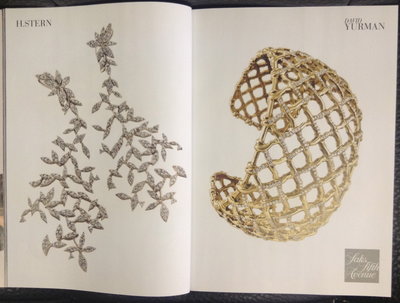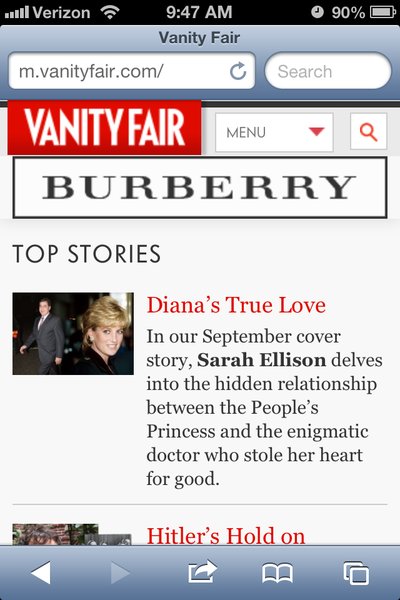Luxury buyers, brands and retailers are not always meeting each other on common ground, according to executives from Shullman Research Center and Kantar Media who spoke during a Luxury Daily webinar on holiday shopping for the 2015 season.
Held Oct. 8, the “What are shoppers planning to buy this holiday season?” webinar looked at survey and research data to determine not just what items holiday shoppers were planning to purchase but where they plan to buy from and what advertisements they recalled, as well as the advertising budget of a number of luxury brands and retailers. The findings show that the channels in which advertisers spend are not always where consumers recall seeing advertisements.
“Publications are, in many respects, one of the primary ways of reaching luxury buyers more so than other forms that reach all adults,” said Bob Shullman, founder and CEO of Shullman Research Center.
Not dead yet
Of 52 million luxury buyers – those who plan on buying at least one luxury item – 27 million recall advertisements on television, 22 million on Web sites, 17 million in printed magazines and 14 million in printed newspapers.
Proportionally, these numbers are similar to the rates at which all holiday shoppers recalled advertising on each channel, with printed ads actually being recalled at a higher rate among all holiday shoppers.

Ralph Lauren ad in Bergdorf Goodman magazine
Nevertheless, of the seven luxury retailers studied by Kantar Media – Barneys New York, Bergdorf Goodman, Bloomingdales, Lord & Taylor, Neiman Marcus, Nordstrom and Saks Fifth Avenue – all but Nordstrom spent at least 71 percent of their advertising budget on newspapers and magazines despite the lower chance of being recalled by luxury buyers.
However, this does not mean that luxury retailers have misused ad spend. Because luxury buyers include all shoppers buying any number of luxury items and because the ad recall statistics include luxury buyers recalling ads for non-luxury items they are purchasing, a direct correlation cannot be ascertained.
Moreover, the relative cost of print ads versus television ads – eschewed entirely by all retailers except Lord & Taylor, which spent a meager 5 percent of its budget on it – might mean a better return on investment.

Tiffany ad in Departures magazine
For luxury brands studied – Burberry, Chanel, Gucci, Hermès, Louis Vuitton, Michael Kors and Tiffany – the numbers are similar, though with a distinct preference for magazine ads over newspapers and more TV advertising from Burberry, Chanel, Gucci, and Michael Kors.
Also of interest is that among luxury shoppers, designer clothing, fragrances and accessories were equally popular, attracting 17 million luxury buyers each, with jewelry slightly ahead at 19 million.
Across all retailers, 16 percent of holiday advertising was spent on each of jewelry/watches and apparel, but the disparity across the former was far larger, with Bergdorf Goodman, Saks, and Nordstrom spending between 30 percent and 53 percent while other retailers spent no more than 4 percent.
Fragrance and shoes/handbags/accessories, despite attracting as many buyers, accounted for less than a third of the spending that jewelry and apparel did, with Barneys spending 89 percent of its budget on shoes/handbags/accessories alone.

Saks jewelry ad in Vogue December 2014
This could mean that fragrances, shoes and accessories could generate a better ROI on advertising than apparel or jewelry and should be pushed more heavily; on the other hand, they have lower saturation points with consumers, who might be more easily convinced to spend extra on jewelry or apparel than on other products.
Perhaps more significantly, while luxury retailers may not spend heavily on fragrances or shoes and accessories, brands themselves do. Forty-one percent of the collective budget of the brands researched is spent on cosmetics, with handbags and accessories up to 17 percent.
The data also shows that both retailers and brands, with the exception of Nordstrom and Burberry, respectively, are behind on digital advertising. Luxury buyers no longer have any animosity or caution about shopping online, so other brands may be conceding business to Nordstrom and Burberry by allowing them a monopoly on the digital ad space.

Burberry banner ad on Vanity Fair
“[Digital] is an area, we feel, that luxury brands have to step up their game because this is where the audience is,” said Mickey Alam Khan. editor in chief of Luxury Daily. “They may not buy there, but they certainly do a lot of research there, and that needs to be reflected.”
The times they are a-changin’
Research by Shullman Research Center and Kantar Media also shows the attention given to holiday shoppers.
During the holiday season, luxury brands and retailers spend an average of 26 percent of their annual marketing budgets, according to new research from the Shullman Research Center and Kantar Media.
Presented at the Luxury Retail Summit: Holiday Focus 2015, the findings show that the 14 luxury advertisers studied spent $204 million between November and December last year. While generally making large investments during this crucial shopping season, advertisers varied significantly in their preferred channels, timing of placements and overall messaging (see story).
Data also adds urgency to the fast-approaching holiday season.
More than a third of luxury buyers plan to spend a higher amount on holiday gifts this year than in 2014, but brands are already late, according to a recent report from Shullman Research Center.
Over half of such consumers plan to start their shopping before Thanksgiving or have started already, and nearly a quarter hope to be done before the calendar changes to November. Early holiday shopping means brands need to reach out to lure consumers into their stores and onto their Web sites before the opportunity vanishes (see story).
Despite incongruences between consumer habits/purchases and advertising spend, there is no need for alarm, brands must simply use available data and adapt to these changes.
“This is a very resilient industry, it survived the 2008, 2009, 2010 recession,” Mr. Alam Khan said. “It always helps to have this kind of research to see how luxury, both brands and retailers, are adapting."
Final Take
Forrest Cardamenis, editorial assistant on Luxury Daily, New York
{"ct":"rQk7w+6655EVmhhWXfJSPavz2NafQFZ0ChulMvV0P78YVJCGpw4ciqUfT1L\/YItGUVCQHu0EbyE1KyO0\/VkfqsGgMgiX+I+ZIkJLnRNODlXgSdnpkmi+vSJO+lGrTkZx9VsNPZRcoB4f6FOcJ6lyPkVbAv3JD+6uea6PT07qWlP1vdIATNfnjli9bLabZRMD7Py3fkijAzvjQfvgkTBmK4Z8KVAsymdQ6\/zdV3q+0anaoVLZPNjZ8KfTk3i7uqiG6cuChR5CRA+AmUKN+4i1gmlb4kB6DCl4F\/8AGqh2Wp8\/7XTqBN9P3e+6jy6holPZHnnY9bdQabvr3K83V7Hqu1Cr9ClHzqxHk0Fzpl9J3d0bp\/7DxKtLDIW0VAbCndqTlyNTW57ZsLag4oi4X9FJEJg7PlTRo74ysTVmIu3sYDDPyPQdWjDtWri2vEp4FvPxc3UVVe+sgjvI\/hBcqtJ8yifUWLT81icE2qw+g3P9uvYhLh8NSAVEy9rooXbYvyiWagh+VJJRO9AAyjM7MVVgs3n0IU1CSHe9m\/4v3lcZZET+3XTpswDeg\/xLpYHQhZwAJcAlNt1D8moOTwai3lxNPLIfkhNwpusOBwyNpkLRs965cKMQrq73H5jgV30Lok9SRV\/V+4kke3rjRgn6b\/wU7ceIY9RHgG1v1Ao6UE2SsZgNhdr\/L22F2rbaa5V4fL3std3i\/Za6SW+B4HfFVmmhEub287Ju32LoAar+RXow29BbsWtDsW2HCxZTd1uL62t2nGn7\/P2pkfLavF\/LSeyJHl1GD7rqwmsrDFc1HN9P6UEsw1nhEg\/5lfRq9gPuxOplWVWdqESAdrAazPTyTQijAXpiRFbPZz36m0iLVvC5cS2WIINwoWi+K+QGCIeBL4FpeYucQao2eNZL4rgJhvTJjbKLw\/nOT4OHeTR27jPef6X++hmYsx65MDOOy2ff8XrNDa9CumCKM+gyDWqnJxAYivAFRIJ1G7JP5ET0czrLu5qV0CyDYjprIKn\/xF+BvQuACY6aNuOTE85a0Y+5q8eeK8mr0\/hrEk9eEry1lqYILU8AH8TyJdODF+h11picH469hXT25iRkujZdreOKoqJnjdKTqAKu+nRdGP+gSrIN8SqrhP0ugNxmmq2V+ACRMBY6LVj6DgHpCHmWaRTy10jBRX5xzwVAPEbDLPCcWV0t\/tluLwKtc66mjg\/0pB+oBUByTDkKc9w2sfXhWYJchcYK4LF2+AhG6OgxcWGJbyomkKEyMjU25q9Bb3gXxJQUhD1hMCnFXEafrl59Slk5WSBAGPSZcLd5SEPEeGqnmzpCcyUDDj\/a6mpNQy\/TwQUygqBj0UzkZfzvwuM7aYmzTqO\/m8d5ZB\/pQrJtbJlmkQzU5sUiUPBRjk+BKBJnxmdko73ej3dby8BhIbniwuf3z4nSpPQpkfyw7T3g5xBQNr\/oWn5HkJzfuGWRRyLPnZq6YYDOxa1Bu7Sv42u3Fu4\/WTlCoW7Mljl0DxyTLrKxPM1U3q9JbIYA\/dZE5SMbWNGtx4mVtS+YPnLsdKrEMYXV0VAFL3iW8cPUT6pT1DhLM9rMAxQ3EzM9v5PrFsHX2mQdBEpAXsLZ1xAlogJHNTWKyVw5JkUy8zT89CnHAlxRGXfQAnBz5A5xXtKVrkNbRqjC3fE3vZ5MuCanTlpu+DxgF09KaAk1PSmVs9bWiEWtkIsVti1aWwGbq4wJrGvEIPeVbT5fPT+Hp1A\/J+YzUfMAV9gvwyTDCZIP0F2XXftm0EpML6TKNRG+kjAxRnMKQ2tshRoP3IHRxex4ek5cjfe4J\/vsGOLpNwBUDuu+82mK31ICZbH3dfHacAszO0RxAKpeol63bEzp9FTSvd\/cIxMgL2p7IR1p0taI134fxpJQ10OFB5y3dKb69hsK0JzzZn+tQ6\/qyS0VV7LuvKrUWOovpIPZxlvIE34y+bfhPmWP7wUSuiiFt9glErri1VJuhCAFM2PyZ\/6rgb2J1M9tckkv4lnGCQGBobJbWu6kWWi\/7ognPzyUsBWHbKrMNtJQiZ9D+mvuqKMymuyMYafdaDCOp+P3mP44gfdmu6AQX04n9z\/QGddTvfR+xD+ceTG2HYqG2zmxPnVyB7KENIu\/44fuUFFHpj\/buR5JRgY\/ePZWJMNb0kCD2RPmymWBj21c7kU2dQPPgcq7qwi04UPYohuEgPT1C70vXd12aLtl4JVD2i83gNLzcmoM0Mnfe4quQVBXMbhH484yG8sKgKiWT7FFJx7iu2VZXm4HeJvlo9b3h7XHjHvppRFhV+6SXh837QPhqGVMa+GfUujNOSlb0QV6lkCVDzhGZM+d+1EM1obBd4yWQNhh0YCCdD7ORL\/3tCWT2ieHMCHLOTjBuTyLEE7Dz4IIFRMq\/8EeSZdcEEGCkfvy+n2AvYmSNsyGYEMt5JEg2LR1eBzY+1XevdoW3hSkUU2QBngdOyg0dfAjf7zeJf1yHLGyOvadh2iA5Xfa4NmFBnSRjT+9IEUxG84pL2ViYm3EutUBQqrnjs4YY3KTCHkujd3oqT4K150HPWla1b\/caSdpUT4cya4CugYjpz\/JaWay03+ytvxlrUjAvrW45Dl8ASa34fsOCOfUCFsrlOu6RZtOH4Mmtd0tvXse8nwkfSrp\/4ACVyww9sUhFJBRe+1mT9vF+uk60aV9cvUOaovs4j7UOQoaqWIUtSTbnx13JzOa4WPYbFYGDFbipLyiqlY7Vh654g66EM+m0MPhn8w3hlZPSbxk+R1aMzVDG2mjT2M8Ai7FNXU45QzqfqxaDKJjoMRfmJ\/MBUFg9q04TZTh5XR7VfsImGPOWRBrY26B+KUrpKgBoZ5J855bR5KAUpvEmXdhEg6qU2GkUCAopmXiW656V+eEGUHxfVXyt4rpDn7VCvy6+AvRdUFpujECzBhEaVQ6LMgM2KltqHtws64Q6IewPfJBz3kqZzUCjU8WGesp7WO5\/WdT5Uc4hR6u76Tdt9rMw8KLirE0EDq09rkNQVCtQ89wXGC0EUcJQvXRJ7Lg+AW8quYtvf5X0TCjvaowUQ7YuoNmL3PMHfKAP2WxoMMzK8BMFDvyZtTENEyyoBH0gwOJ\/vQAlUPGcOUJN31H2EO8zTNgaNdujAhmrfdJmAgrXMiHCEXO2I\/5eIF4NRTmy3cgaJ1CfKh\/5TKnxuFB5tnYdX+6ti7nQDnGQF3STvrSHO55GDFp12dAsSnVeXOTrd2Y95NffAX6qzlsgIjM4W61dtENEUUHRIJSF5dYX5hKJQ3yuKJRE6YC+PJZaG9tTmALMp\/3LK3l+9TRoQp1rs7RW0QHGAsa9vWzwVGDRNyX0xrUaQCqYGVg3JHrdQQLoxDBljQjpyXZzfjnGdVoAeTOFMK0Un8DRNKUGXVNeQav3baRHDuH3Vw+M58WI3UqYPn9LFsSwzocdxu9Iw0reiIpY3e+lp5PPDU1SMsjp4e4EBO\/0sih7O4cK7Bn+XEHX0beOxHT8o79yKMwdPTvOo+1E4DoPZbMcytva+4La2X1O9kwh6ZfMe9hM9P1Ok\/Z7oGica8fddCeeBu52QApbAHju2BEueaOA+tOEru4Y4VVDVkQyqOGYyK1udBqGDnPNuBSeHKOJs4X+Tqbf5fgX3tRWz\/hN8R1pcs\/DqnWANVtdGKNwlDTzzkpFG1y76m+JUidCPlDbU2eTzfWgNdxi8nQwarj\/UCjcs8HpwYnNcYrJDr8VmPqLDR08rEqMO113MNrBpyC7dJfH4JsUeNzm7HGz\/hMRSYLj\/21kIIdzrfKnKOGhRyvNs4q4MlKqEcGfRcPMK9tuGUL3IgbcNKZnC4IMTE4BjDeCQdVOv29i6EedDTKBVOEqafX\/ofRCtrvAKz9DyCkzIlZUCcsmyDBAKBpscVvGQI0Z1CB1YazAiywckghy2LhietNpKX+aFTr\/lsTxHhQKSyjKKlki7HYihopHDiCiCJB3oLyozoccsH9bZBvsnpL0lN1R7ug2GzjEYo96QZMMMOZ8kujgSMOt3ucQJnNkfZQGz96Oqrbe+qLjlb7cEf2gvn9jSk\/5dR3we0mAYWb88v5ZzFiRvSmEeYYNNBCm+D+Xay7vOpwUmpo6K3hvRKg6flE29OwlYtRFWJu1BA6kdV5KVtclKaAc2Xa1m08H12CKc8+4zjqFFmspWcmKK3M0ul3Bh0+AsEQ4Yz9SdvfmMXVrAk6zRAo9MY\/HxaNAc37LJYWd8kUIxa0no7VyP5ncKP\/kUHMBY5JGyizGQWZ8\/ZJm2eHZuKAMmqIxa2Q9AmZmObRxT8FEiGfnH6qhWqswOq707FT\/vkQ9ERnQKOpv40jjxOrpCgHnJoiVtjm9A8RMSy7XNKm6ELCJqBWt+lHcq454wel0D7bkDQpT62AF2eYFCbFqSfUxxy2y8fVqIye+tSvzdOa4cQuHl48QWWWvm4NiGj28JX+H0rhXb0zW9q\/8GckAGaySF\/oy1sdUyaf47uYwj9ravSpt8GsCFMM++os6pLI99J8ImYjqzuXQj2hHDdHDHUmh3CBnWUES9t3vpFmTKndwgf+DMRCSklENBe3\/FjsCzVNMsVErDViFjaor3yhCdcZqZmbDfXc0YoTygGYzL1unmktY2dQbf20pyVSRHqqjFByWNunLEq8dbpA4oOyLFn9djoQXbmsplhfiTkbc+Tfrvn5kF1dOF\/q9KCrM4soOkz778Ij40GSRK1sVQMzO3NoT03ZLtTbYEpL3qab9r1LXUHj2TjWXvtgYqmRvTU8gIVMFD89wnMXrdGo9gIP9c\/HkXlPR1uujhaziNWsg91eZTFqjPaE3LdnzQgsppQzgSk2ccpkojyUUSbg01A4fqBzJJoDztbRuny+zJHKdrM7J3biA2+TRoStFOWb0HixOdgkIYbioU169uxRbRUIxBtp4RcGZd5esf0XPiejmuJsAj084uYyCxGqkOks0fPTP1VnMrF0pLor26g4ptLveTeQfFsP8pZSfTOD7gWMgD0vE99MViA090X+i5bjoYuTDiTFAatn4XcvaYdZ7RsUAgvoJQXUhg2SSCqAQLLeKKmi1kxCcuh5GJPonvzy4j41epN6MCbvtjMk24wsWNDWVL5g8Eni5mqJOTY0KC8hvYmLMRQ4iNQhKQOr6iOEvZVXOkwrZHWgWEveOxy\/tE38pPjuC22pkEEDBFQXCDEkn3FixFCm5HVf8DeQ2TkDidMos1Dbxsc+MMcbDA0Pio\/ZYDE4VUgeBu7uprzgPcuadHfsp2xd9kw1v0kdaBrIHKUw2d2A2gHa9OhQnlsa4MPSQ96tLvlMZ7LjqlRQCjxZZXD5QKzr1F9HwizpRRKKbbo0XDGlLB9vfrDN46hTc6giGcZ6KP8sxP\/C0QA+mtZhFiV\/AgfwiWUBffWJfQz5PujGyrJDpX5iMfQ9u1JT7jC066NY\/ht\/ltbxHetLCUTVchbJ3gfZANgUfCUfFD6zFOAKCxbqgsNdBeWgCMl+e5POFSGAGfQwQtG8Itn5cQjfwweFmK0sMRhcBfRsWRRoJqFBcY0n1pHm1BKZVaMigCmhXvzcwd2zMX6WBDd4uHwJ364vJB\/ySGyGxlo7jKNZZEuQ98G9Zqjl\/RJ\/Y7+KCTT+NnAfyR1v1EtJ8M3hG4wC2IBSYNSUH6z2226AcLgkFrvA10shuHmYqEf8zcqNjcNIaETsXM52ebEgo45dmzYi7aoDSF\/kdk9u+S2NzckSFiywsYyhnCaAJkIG5f4NdwPO5T7c7aTyIFFcg4b5iw5fBYajZDcty2A8q3Qcm5YzktAN082TaRaF5ak0Wpq1\/PwwtgF1GJsUyFR6LC5a7YaUijOHW5PQoHE77PE4pPqwW70UFqcqsevVyqqqBNN6d5dTM\/vwlc8E2Hsmjtn\/IGQJrde\/KtJkI064TlQrqpMdGkKJI4Cv72e2X+\/QWoiodk1N2RC\/tOaZWg0F7x9iqK0FT53QGDqlhx34h8NUYf67YoZMvA1x6XeI43FLLP20QaRxH9d4zhMjyjfm6KEUZ\/zBffNxC8XTTARgZ0Xez506AD9zaSZI6DphXjRVODYcZgVfjzvDbuCtUcSTNNYlvdmOiFsDd\/yYKWJOiBKHPQkkNouff2KzlsH8SkKV7QtuRV5h4BMQg1W0BUXr8VnHsGzM7EuM3uJZ6MrKXKbUpYailrbpnylRTcMISi57yZm2ZU5Q8n2QQ0IwIBb6VZstdDD0BBj6rONY7qjS8\/tx09Vvjj35WLCO1iHkBXHhYdjp+F4NxVKUOvB6yL5LrAp\/6GpGq2xFNWy5cltEWFS6JPFp+Bx5IBUDl75Vp4hJBaKgG0sLxUq1DppmTh4uHpxzN2lrWVUfu8eZ89HAwJxXxe\/uS0vyJ27seyi+QsmR1iLW+OxOKSCX2z+qwZ1AR0fYNKpyK7r5sW\/5fH6RDfUATCzn5YlcCZc0Vm7Oo3DUKydlZ2PZkePDdNeLC2h5\/VODnjCzkrT4Cw\/h\/4tn1Ux5YWpmsVfdEBJSZpo5+zAyNKDfsjCeaFx1lP9r+alfNsNr5+VTeC1VsWcvT7O7gmGAcODbDnaJgXtlB83jYVREji1Iamr0pEVL6VTlA5gvjgTEcMk6bhsQ\/95HctPNaEz9oP6T\/Ra6v+6s6Wtu+\/kLd0MiMyZwWHGPy67uxYW\/aLDOLls6ZQuR2T98gEKHdcZMw6c0mix+vb\/xSKRNc0o\/6NU3un5Ym4TUrpViKcMo8Pu33r03Uj8U5FAGqYVCH\/s78myyE0vleLvkZLD74UT9KNrwcszxz\/Ps2K4TUWOE4gYyvbWYVwjSkcSRZXOLRjAbeUyyFo5yxg\/0pZe2ZSqGhMY2oRGluq1IS+VGGHlSFOYZpkqPgmPIBOFOgFm4DXi+wPvz4lSUaLrvQNRZKzGmOOFldBeD1RET8NJMwimhOXvBBOuz3FgjC3SaWDHB5ogvSeTOGjCHzOO5UrXwnTHrxi4M+UJT763o9Vdod6GX3nHAbhuEbOGgIOlSkKExTbJKqLd9bXtyvPV\/U3eVSY7yVXJmnlpZu6azi6BXm3D+pN11nLSPuIPzNrqcwGtNmlWvCMeRS5UyQbHUlk4Ik\/P6owMdhOI5xxzG+iC+iYNzP9erJcmPb+bz45eyUbMf8\/vVTt5f6L9EPwNUKMBL3W0jAag9Btzb1HyXUa08KR2Np43d8\/pGXW8dtSXwU4agpvpL8yPcxDqJRhxbSmnpSG8ERm44bNYiawZex+Rd6nzcxZM8QevsDzK2lr4VX4h4o2tYOfZpFvMqlK61DvwDhVmNOJBWccmGtzRWyFZgcbs4zcvmFTt3OKGE9OFZGvCVr1kzgPrccJ207sT4z2H3WjjdQo5hvlr2eZuh4GLqDBRA2z2eKcV1VDZ+ZpTsXwlVPEet\/Ru6YftlrH0ebeJcUKQ3iYzMb9h2fbX7JEcQKS9htAwYoYRauv+VRsg\/npIB5wmole0H9u5arKaFHXHUgKnGJvzEctH4mDYitFmz0ZPD0qSLeJi0zI5Qv\/yP6GJ114xfK6RWftRUoi2S0VDPCDfJjcKGGxHdYwvrC8voueNdHR5dSm8zIUE5aWHxXgPlVac1TBCLRCXI92bjHscrQUxEMF3y6b9BKXtPJJilxMgk+lTe5dfW68MYTJXnjOtQXBy3Rv58AhlDY3CSy4ERPeD+iwNzawl1QpnerBjAD\/46sDhAUJKPWupf7W0SIVZwSCUcpRzlQqs34FQOJYNuVykfUY4n001NBem2JxiPk+ngJ60o\/5nFaDJGwKwpNmIakXK4LmJc9Zn+ai7mtpV5lTicY+o6oN9UUzy05dZpGXNstQ9xbu2F7gnNAR8CK1qoSIFDrS4yMD2opYX+QH+jSiA8exyTsX9Q3WKFJ4NLhCicrBgeXun6axA6wfSM\/5m5v0mL72mwFcNEyX+ZBLp6WcIFhG3IQYhfZ47E31+aUBm48lg8Z2iU1\/YiYJCYfScitti+h\/raZPb4He+zpCksKqP2ggTlcKNppN9TG1AYXo5wJ+EhZIGx\/DTe9mMaxR9bDrimXA2suPuORKlEmgJKOiS4JT\/Fh\/oXfp05p0cWKQ4wk5+eALK1573yZe03a85JmgEE9KYmFQ1IQIn2ZcSRHctrhAwgRTcNd7i+wVt3bpLx0sASnUoRsoyuQ+rR+cXIIrfpFwSeF9RXYtODQqP+ALNfe9lXH4363R4GzyNgBOUECPf9bdVKJ4WFnvzEb9Tz7qqM\/IFR061Oa\/AyPtSgedDWzNseQBvZsMBzfrvfJ843EG82q2p+OOnj0eQ+FNKb8AtijrSl3dUKFh7iOEGbMyUkVlTrej6w2rFG3m0ihGsBSjJOC6oO6XFmqa0p7Ve\/315SOdbVw428gr73FIa02nt057Q3kJbpijJe6YD+7IVERZyBovm+iCho0XcTGTK67+zjQlpVgUDbz78bwsfHCKA0uwQ8rFnS2\/\/yvQnLuz0335tcxwXQlgYl34CAtHa+0KbMeD+7DADIiv15uMaBoubFQNeaEiKe7oo8ghoSfoJ05jJtsY4nBFzTozCtL+Ic1E\/ssXsbs34yP6I92izmCFS8Hksfo6D1LbgK+y1mdRNsdEmnVb2lk9taip0Dcf2kqidZVKye3n7dF\/5CiDHLYwwA+tXcMgM4xSeFDJFuW1UnZnY1oW\/\/qAY1plpz6+5GH3BtD\/WEoP78k9z2shh0sgT\/DI4m+OH2nHeWCsjnnUkwWLFOZKvvGOoRrc3KeyvPIOdr35wHCMmCDfP32mC1HiOSKhAqYDgkVxzZT3FZIJF8x05YYCEBUYoY5703FmRBS5pFpgoNIbG\/fh34Dn9oUxVSpTGU6++v3ErG4czwvTXdpcL08mcGkyDiOdIthIuBIgjJqE1mCOnNovY\/7Mks4BZ\/rBVzFgNMkn2omRDFTMebiTRp6QEx73Ir\/baA3pTcFgMe4tt1wgW7pSu+jmoSNJIOtV3ggv8s0jyw7XnPTQ2E63QZLvCQSMqQ4lq5yK1yRHW6pqSFeNuYaBKRQ3psKUwv1Me0hcS\/DtUkU7IjFgj6wx+L53KkNQQA7hQSOhKeMJH\/qtS8SqmFB2wKdvvXWpInsZT1utelndrChMwkS4aXz1+VOv\/oA2utAeZwDER+cdAmXfP5DAUdaalIdbDj30+B1XgCtli1YsPJQ2VTNSkLdHXutq+4Ia\/R1MChaLXO33mTROXBfhhlhX3DYJhsAHIFSrN07NCDkDHmsEAcanbfhijQPYd\/DaJCXZ7NKt\/ET32kw3Q4iJQBFAvepyJb+jCB4iF1tytkPXhGkerL8ZUb+WeUCpE0bGgatZ5SBUYI7elaIR5AsEAk1CMkjiZQuH6FqNke6hVataVS3ZlDULH7XLBkN71HhIRo6V3MQ17AxixnWsU6SSwJGoZKdHoKsi06Ku7xY0iqEfNfUWJmqqzO0vJejnK960NiI8kDyICrSIK9pR78TEqVR5hb9Qh0VInZ485MV26ndUKh9LT+vzfa\/WuuUTX2J006d+Dn7+7GVSVoMOyzyFKqRAUT4BaK4WiRjSkqzB9Exao7b9PVexLOv7xAENBm+g2081tDtuY\/KEyyp5Jg39LgDfcT\/2O0zNF1uVKQh9Z2NAc14K+k0n3ifRzMkS1DxtujjfdX6bUwfqtaI23mU7hYKaJPOGKEUR6yQnPyNMjshk7PHi6yl10cM+SIScWIALRqF4eaqYKJjBiVLmZx7TPfJsYD5Le5eutz1NySkcz7IyM9h8OKqNyPIzfry84D27Tkw58gdrfxFtThGZR7TdQZFVTtBQAgzivBwMJl0797sOyRzdri3AsXNLQo2\/Ak4yP53SKDPCLiAOGmhc\/KHAcomTGrWo8MoDweX3UEcj2ILk6mTU931GKOPSl3NAtat+SiZRTga6D02XWz7Drwh2w0jWLw4oLMpULDjVbDMNtGtGugZvUgHtR1\/HS2xdIEfHDssPB4Iu\/tSICnOWhgf4FcvE6K1d3EQW\/W6xBQ5r2x0phjDpmN115qRTP04UuU5xEElnsOdtqE3omlkQfPrBN42bdfUhfZiNaFl\/\/YNEloPejpJwmcabEBIV7XyulJKHY0AVg7oCIBTzwgrKM82URTOkOtzM2vZkZnvlevoVecJQchXePx\/v1dPHpBCb+hXa3nVImRy5Iqh\/lhIdi7I\/wN7cuvyGrCa9VY2hiHWupISZgZJ2cxo0TMDDQK9TbAFIIWaMsdQQnPIbqUm+dI++lHbCmXzR\/uRHdStyjwhGiid3NR\/FmDtxId5HdtyQFnOY19gyMO5triDlSywlwravWT5PbfmaW9WJMSrGLwddSvZPgJpf8b93gzi2u76gu1rFnyqVg3AOushI\/r\/zOvXtRGDcCSMdp1mhQ\/ohneICSLfrS9uE6LRioK+L1c1bJfGuMvKPXe\/8G9fqGHCR11NaAJx3C34Jkg9H3z\/tTGrioYupA8tE\/Emqjcx5hCeN1NaXv8iUjPDfUrg4nJAs971KbOxLMGHCS2rueVpNqpLR\/OeqoNB0II7LgypzaIG+FZuLgSExG2jENQ7xeRkF3kT\/xQGvwlacoXdB1A0VRUB9eFVFCBOwOm\/8uWEHXPOiaL9+NbzuDGa65eh2gdDjCI9vAtnaENkIiaR35vaUUP9IDuuo2hEuLfUkModZ+oRW10J97ZLtlrZRcFDEaDxEUNOiWjPLKdEhSQDvOaU\/LYX9MmHSQXavI9GHcZfQDIY7\/0aOB1eY\/5h2bTgYAxNgJjG8zWhBlVyESBDaqUBBl1F1X1IRyN0Oo3mYbj4LWU\/KegHxxmoDReZVBYMqh4N8vmGbkJRH4+e3cGB0Lj6mJkMwA2nw1vM0ozXjzYTZixeoJkhmx55tGnh6OBhN91nZXvpTo3Jc2FKudl0+RSxBHwtNgonAdjakrZQZbTETkEu+qlU6WculnsllQeLk91WqaefLy1Ts0butqXu1QZ1go4pc+MumBfXmQpMKO\/Zj7Rv9F0pILRt9DLVAcLjo58GmRI8AJhvpNjijo21QtEb6PEnD6lTpCLqfMIzQIfgeL9+k42V+WZ92Dq5\/qLhEbHoXFBQp7a\/qTgPn1EFYdk4Y0rDukWX1UJWxe7z+IPfn0b8MFsXO5rkgMjoaGAFoDDjEyNAQrdKxcTpfyUMgyI9e4tC7ClsKvQ4bj1OU0Uz8mzcy5EKLK5xmNW0wIJVlH2i3DvlRyjb5C8PoFPG082SLbzyP39W\/118ZJqbvpZxfTo9JSN0QEHNYUlTHW1QMeSzfzGGjWa0LibXqnk\/f0SERi\/RrxCb3G198I8x4b3e95kPifAfWGwa5r\/7TcgEr3XtBdt5RxoMMM4eyW5eO\/pfrUcbNrqSvg4gFit4oQPzzcx6myu7D+zlXugEN7Y0sytJtVUWgyyrM+F\/trSej5+8bicfrNleHgWKc64TykW17QYxmy5xj8Yy\/TVxoI0Ia266GHtFQ7DDVooBA6CTICrf0wg0RVw76lEVqezugFL3F9ARVAH1pNsUQK\/08sV\/pt9SQ1Kn9l9PpSIrGtM7ltlUuKKAgLvChXLHfjPyWOZKpAMsTLPlLAlrJHkRn82vT+dghq2cCs8OMaPJNgyqudgrOAFEgYY0K39hedDPPGxRCdbX0sE5ijnjxuQx+PM8whklvz\/zHuS3mKqDGyzIFJkSdFUtKBxjV16O1A6oB+9vouOzQ8ST4n04I3radfYAu+jry3H5mB8R1YwTx7bg0axD4qab\/o0J14htJjH+gC+BikLkYbYd94tOV8fswGU6EVCtfSLPZCtb3+ZWnnuInjQJ1bf1vCv2xfAswWvqxGRSTxeSd4NXPqwqKDuAvCyth3HA51Ao831G9Astpe4qf8Wb\/S+nlFq+aPmJaqjrfQsCLM8C8U8yf4yQ346","iv":"257d573a05081d82c693920e2ea92d1e","s":"f136f81b0d7255ee"}

 Handbag on Louis Vuitton fall/winter 2015 runway
Handbag on Louis Vuitton fall/winter 2015 runway